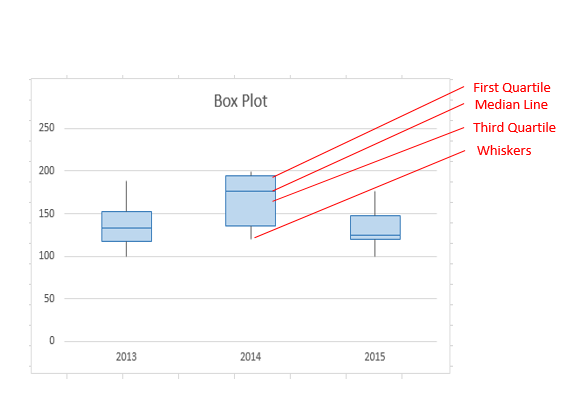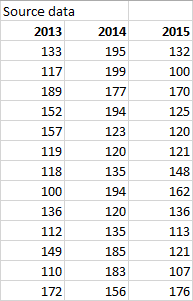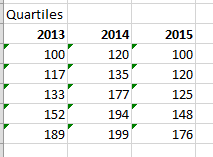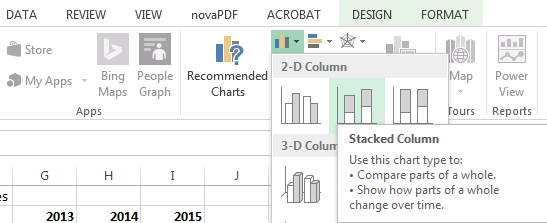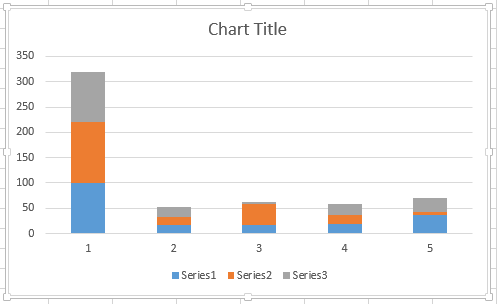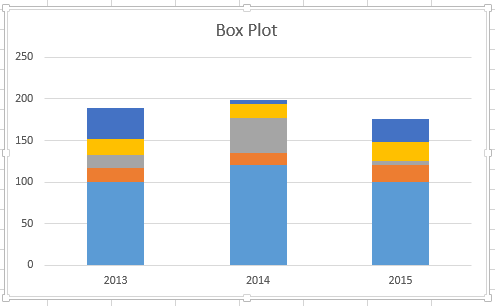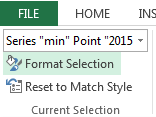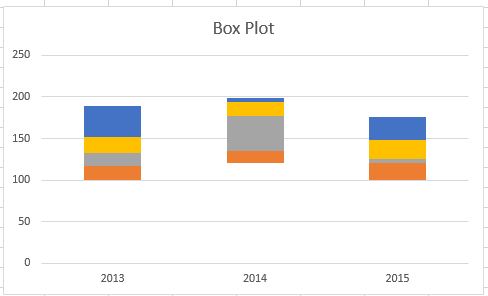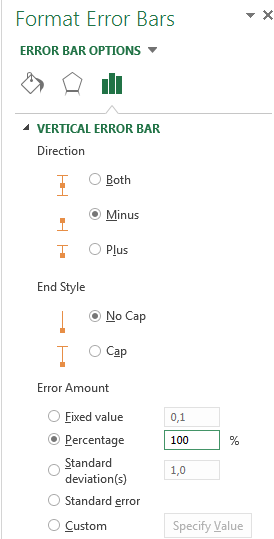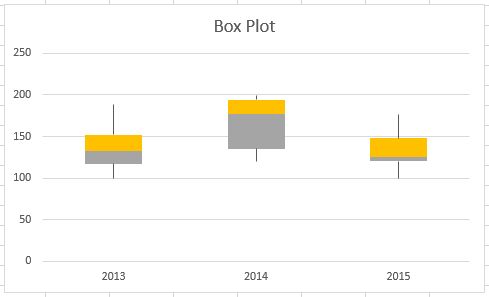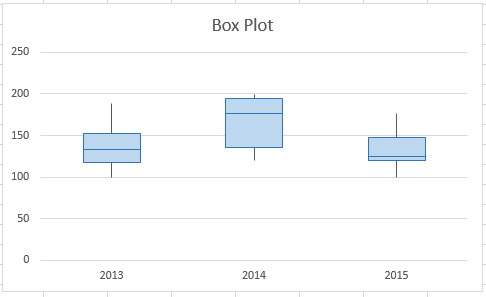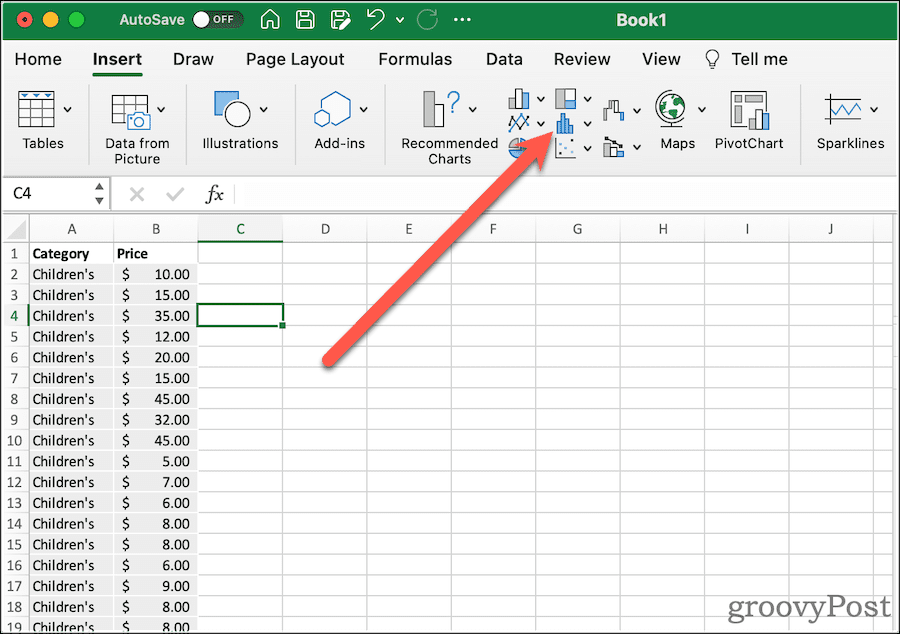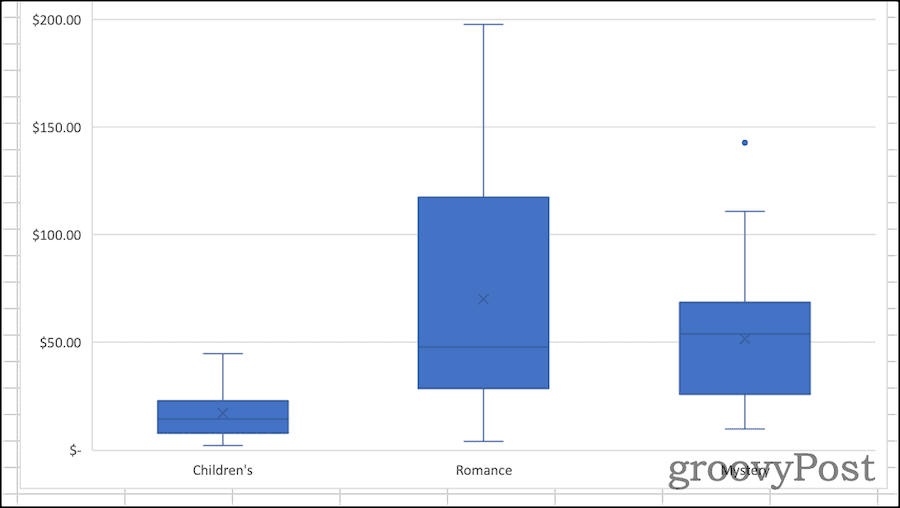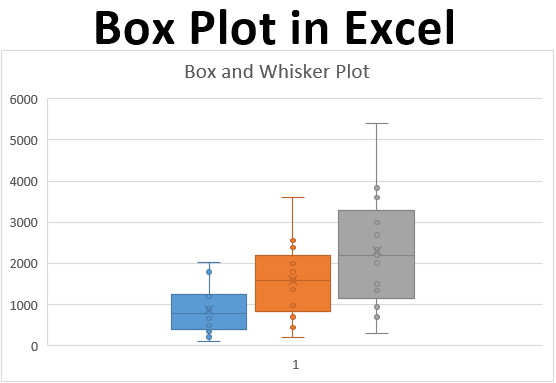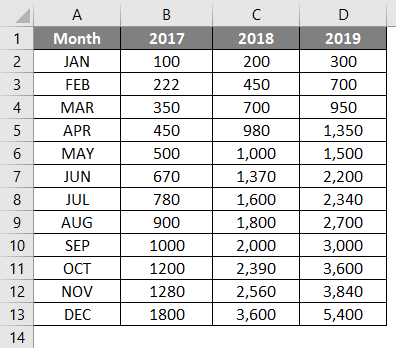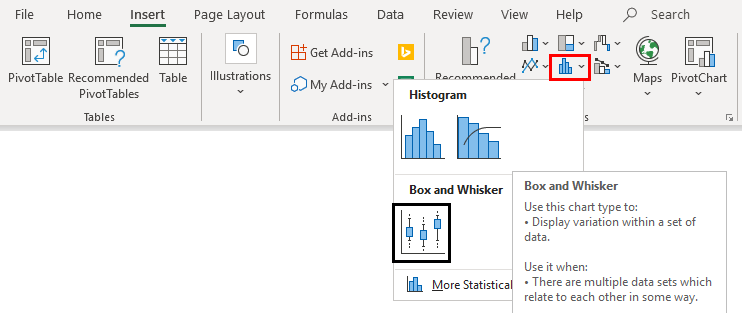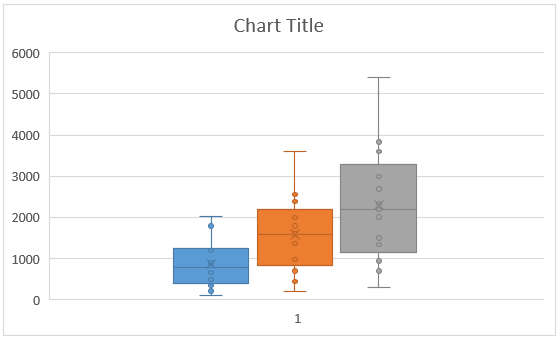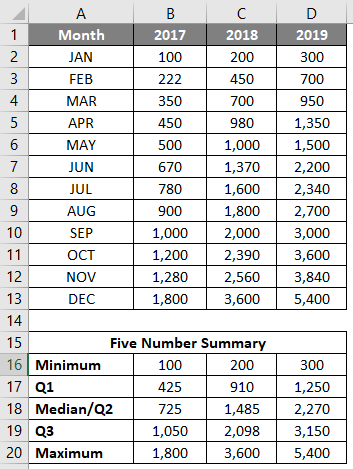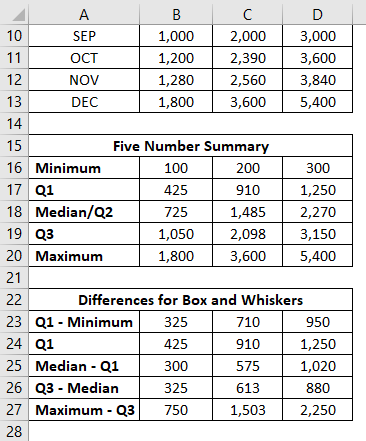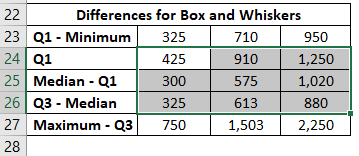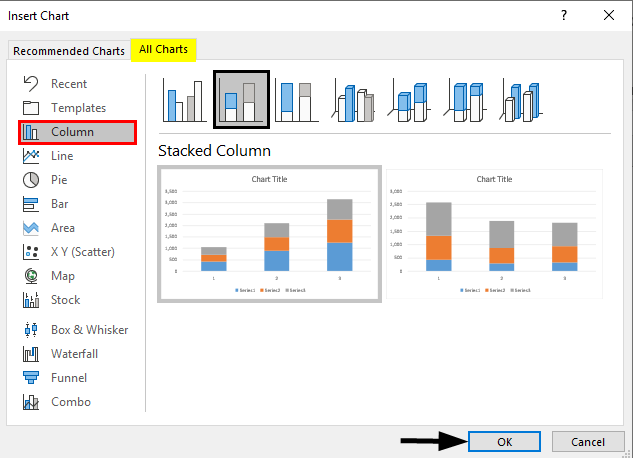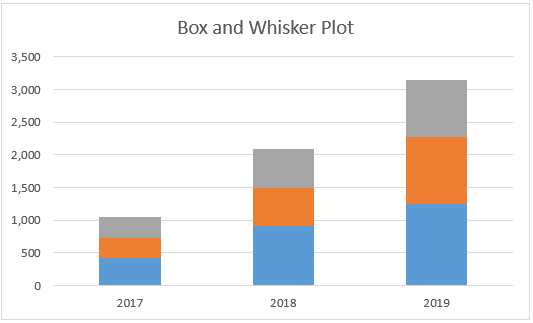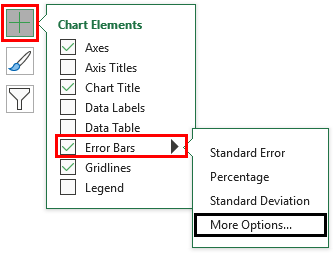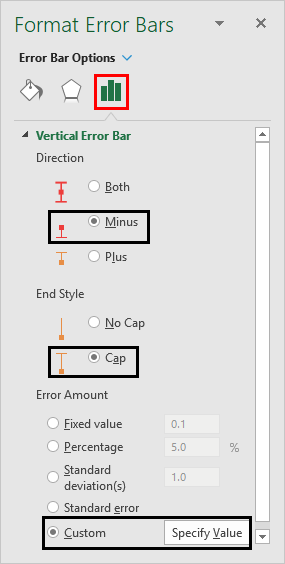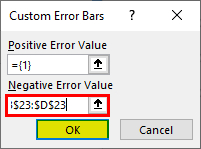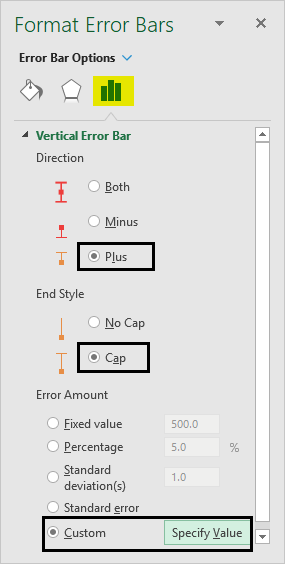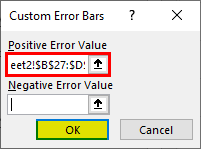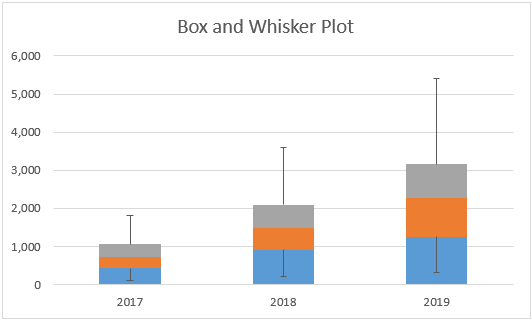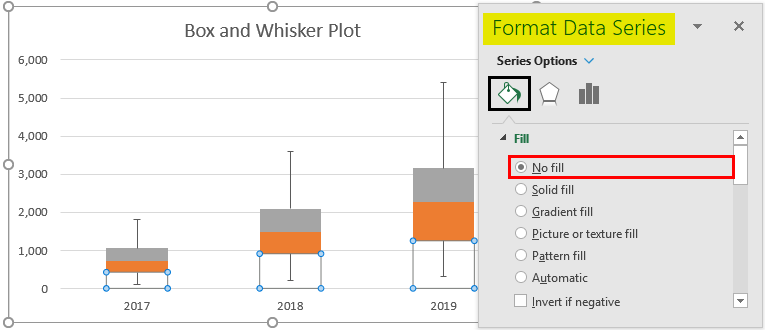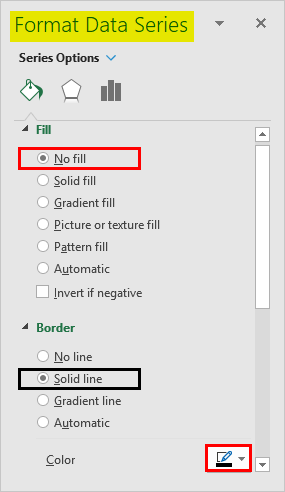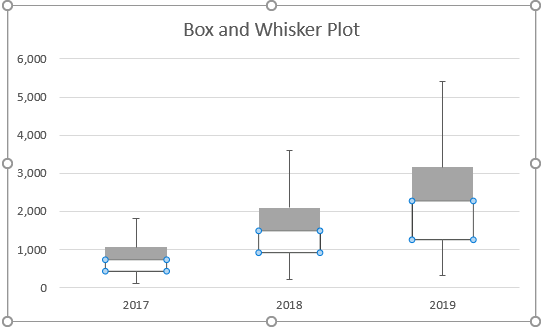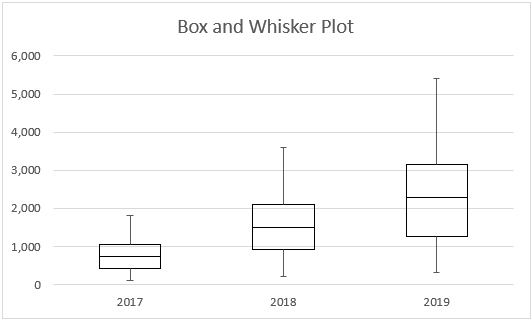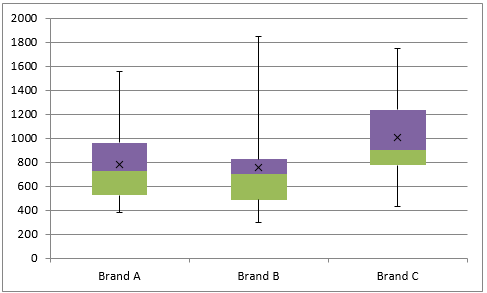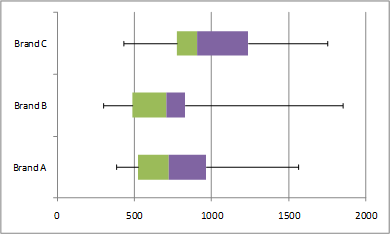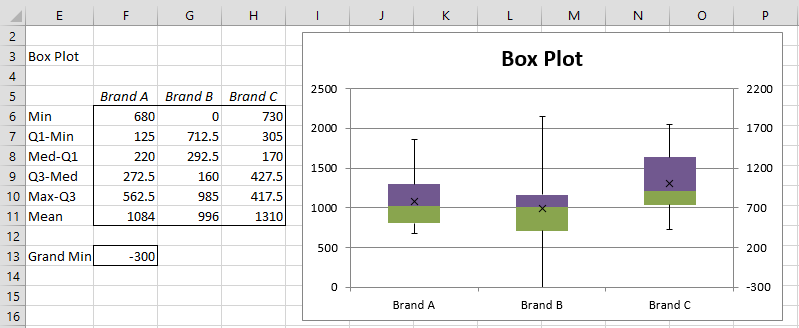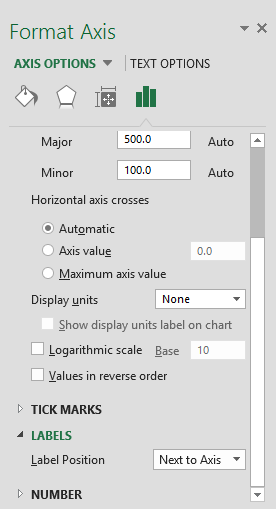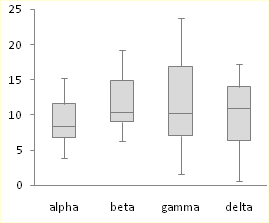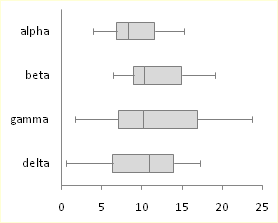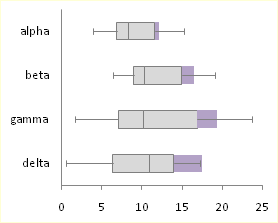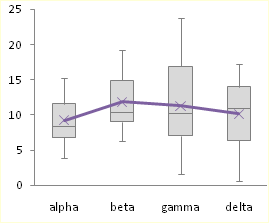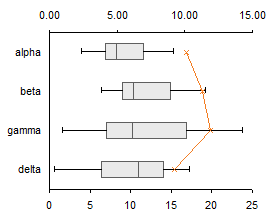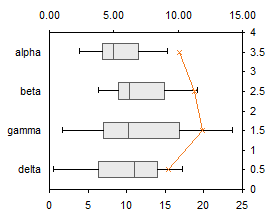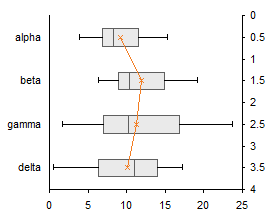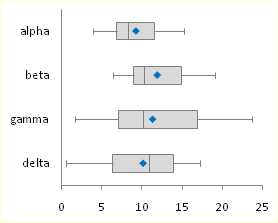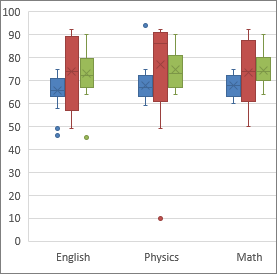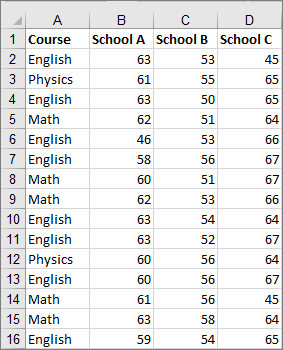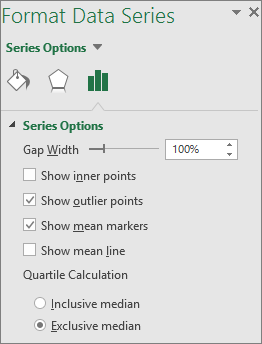If you’re doing statistical analysis, you may want to create a standard box plot to show distribution of a set of data. In a box plot, numerical data is divided into quartiles, and a box is drawn between the first and third quartiles, with an additional line drawn along the second quartile to mark the median. In some box plots, the minimums and maximums outside the first and third quartiles are depicted with lines, which are often called whiskers.
While Excel 2013 doesn’t have a chart template for box plot, you can create box plots by doing the following steps:
-
Calculate quartile values from the source data set.
-
Calculate quartile differences.
-
Create a stacked column chart type from the quartile ranges.
-
Convert the stacked column chart to the box plot style.
In our example, the source data set contains three columns. Each column has 30 entries from the following ranges:
-
Column 1 (2013): 100–200
-
Column 2 (2014): 120–200
-
Column 3 (2015): 100–180
In this article
-
Step 1: Calculate the quartile values
-
Step 2: Calculate quartile differences
-
Step 3: Create a stacked column chart
-
Step 4: Convert the stacked column chart to the box plot style
-
Hide the bottom data series
-
Create whiskers for the box plot
-
Color the middle areas
-
Step 1: Calculate the quartile values
First you need to calculate the minimum, maximum and median values, as well as the first and third quartiles, from the data set.
-
To do this, create a second table, and populate it with the following formulas:
Value
Formula
Minimum value
MIN(cell range)
First quartile
QUARTILE.INC(cell range, 1)
Median value
QUARTILE.INC(cell range, 2)
Third quartile
QUARTILE.INC(cell range, 3)
Maximum value
MAX(cell range)
-
As a result, you should get a table containing the correct values. The following quartiles are calculated from the example data set:
Top of Page
Step 2: Calculate quartile differences
Next, calculate the differences between each phase. In effect, you have to calculate the differentials between the following:
-
First quartile and minimum value
-
Median and first quartile
-
Third quartile and median
-
Maximum value and third quartile
-
To begin, create a third table, and copy the minimum values from the last table there directly.
-
Calculate the quartile differences with the Excel subtraction formula (cell1 – cell2), and populate the third table with the differentials.
For the example data set, the third table looks like the following:
Top of Page
Step 3: Create a stacked column chart
The data in the third table is well suited for a box plot, and we’ll start by creating a stacked column chart which we’ll then modify.
-
Select all the data from the third table, and click Insert > Insert Column Chart > Stacked Column.
At first, the chart doesn’t yet resemble a box plot, as Excel draws stacked columns by default from horizontal and not vertical data sets.
-
To reverse the chart axes, right-click on the chart, and click Select Data.
-
Click Switch Row/Column.
Tips:
-
To rename your columns, on the Horizontal (Category) axis labels side, click Edit, select the cell range in your third table with the category names you want, and click OK.
-
To rename your legend entries, on the Legend Entries (Series) side, click Edit, and type in the entry you want.
-
-
Click OK.
The graph should now look like the one below. In this example, the chart title has also been edited, and the legend is hidden at this point.
Top of Page
Step 4: Convert the stacked column chart to the box plot style
Hide the bottom data series
To convert the stacked column graph to a box plot, start by hiding the bottom data series:
-
Select the bottom part of the columns.
Note: When you click on a single column, all instances of the same series are selected.
-
Click Format > Current Selection > Format Selection. The Format panel opens on the right.
-
On the Fill tab, in the Formal panel, select No Fill.
The bottom data series are hidden from sight in the chart.
Create whiskers for the box plot
The next step is to replace the topmost and second-from-bottom (the deep blue and orange areas in the image) data series with lines, or whiskers.
-
Select the topmost data series.
-
On the Fill tab, in the Formal panel, select No Fill.
-
From the ribbon, click Design > Add Chart Element > Error Bars > Standard Deviation.
-
Click one of the drawn error bars.
-
Open the Error Bar Options tab, in the Format panel, and set the following:
-
Set Direction to Minus.
-
Set End Style to No Cap.
-
For Error Amount, set Percentage to 100.
-
-
Repeat the previous steps for the second-from-bottom data series.
The stacked column chart should now start to resemble a box plot.
Color the middle areas
Box plots are usually drawn in one fill color, with a slight outline border. The following steps describe how to finish the layout.
-
Select the top area of your box plot.
-
On the Fill & Line tab in Format panel click Solid fill.
-
Select a fill color.
-
Click Solid line on the same tab.
-
Select an outline color and a stroke Width.
-
Set the same values for other areas of your box plot.
The end result should look like a box plot.
Top of Page
See Also
Available chart types in Office
Charts and other visualizations in Power View
Need more help?
If you’re presenting or analyzing difficult statistical data, you might need to know how to make a box plot in Excel. Here’s what you’ll need to do.
Microsoft Excel allows you to create informative and attractive charts and graphs to help present or analyze your data. You can easily create bar and pie charts from your data, but creating a box plot in Excel has always been more challenging for users to master.
The software didn’t provide a template specifically for creating box plots, but it’s much easier now. If you want to make a box plot in Excel, here’s what you’ll need to know (and do).
What Is a Box Plot?
For descriptive statistics, a box plot is one of the best ways to demonstrate how data is distributed. It shows the numbers in quartiles, highlighting the mean value as well as the outliers. Statistical analysis uses box plot charts for everything from comparing medical trial results to contrasting different teachers’ test scores.
The basis for a box plot is to display data based on a five-number summary. This means showing:
- Minimum value: the lowest data point in the data set, excluding any outliers.
- Maximum value: the highest data point in the data set, excluding outliers.
- Median: the middle value in the data set
- First, or Lower, quartile: this is the median of the lower half of the values in the data set.
- Third, or Upper, quartile: the median of the upper half of the data set’s values
Sometimes, a box plot chart will have lines extending vertically up or down, showing how the data might vary outside the upper and lower quartiles. These are called “whiskers,” and the charts themselves are sometimes referred to as box and whisker charts.
How to Make a Box Plot in Excel for Microsoft 365
In past versions of Excel, there wasn’t a chart template specific to box plots. While it was still possible to create it, it took a lot of work. Office 365 does include box plots as an option now, but it’s somewhat buried in the Insert tab.
The instructions and screenshots below assume Excel for Microsoft 365. The steps below have been created using a Mac, but we also provide instructions where the steps are different on Windows.
First, of course, you need your data. Once you’ve finished entering it, you can create and stylize your box plot.
To create a box plot in Excel:
- Select your data in your Excel workbook—either a single or multiple data series.
- On the ribbon bar, click the Insert tab.
- On Windows, click Insert > Insert Statistic Chart > Box and Whisker.
- On macOS, click the Statistical Chart icon, then select Box and Whisker.
That will net you a very basic box plot, with whiskers. Next, you can modify its options to look how you want.
Formatting a Box Chart in Excel
Once you’ve created your box plot, it’s time to pretty it up. The first thing you should do is give the chart a descriptive title. To do this, click the existing title, then you can select the text and change it.
From the Design and Format tabs of the ribbon, you can modify how Excel styles your box chart. This is where you can select the theme styles used, change the fill color of the boxes, apply WordArt styles, and more. These options are universal to just about all of the charts and graphs you might create in Excel.
If you want to change options specific to the box and whisper chart, click Format Pane. Here, you can change how the chart represents your data. For example:
A Welcome Addition for Statistical Analysis
It wasn’t always so easy to figure out how to create a box plot in Excel. Creating the chart in previous versions of the spreadsheet software required manually calculating the different quartiles. You could then create a bar graph to approximate the presentation of a box plot. Microsoft’s addition of this chart type with Office 365 and Microsoft 365 is very welcome.
Of course, there are lots of other Excel tips and tricks you can learn if you’re new to Excel. Box plots might seem advanced, but once you understand the concepts (and the steps), they’re easy to create and analyze using the steps above.
Excel Box Plot (Table of Contents)
- What is a Box Plot?
- How to Create Box Plot in Excel?
Introduction to Box Plot in Excel
If you are a statistic geek, you often might come up with a situation where you need to represent all the 5 important descriptive statistics which can be helpful in getting an idea about the spread of the data (namely minimum value, first quartile, median, third quartile and maximum) in a single pictorial representation or in a single chart which is called as Box and Whisker Plot. For example, the first quartile, median, and third quartile will be represented under a box, and whiskers give you minimum and maximum values for the given set of data. Box and Whisker Plot is an added graph option in Excel 2016 and above. However, previous versions of Excel do not have it built-in. In this article, we are about to see how a Box-Whisker plot can be formatted under Excel 2016.
What is a Box Plot?
In statistics, a five-number summary of Minimum Value, First Quartile, Median, Last Quartile, and Maximum value is something we want to know in order to have a better idea about the spread of the data given. This five value summary is visually plotted to make the spread of data more visible to the users. The graph on which statistician plot these values is called a Box and Whisker plot. The box consists of First Quartile, Median and Third Quartile values, whereas the Whiskers are for Minimum and Maximum values on both sides of the box respectively. This Chart was invented by John Tuckey in the 1970s and has recently been included in all the Excel versions of 2016 and above.
We will see how a box plot can be configured under Excel.
How to Create Box Plot in Excel?
Box Plot in Excel is very simple and easy. Let’s understand how to create the Box Plot in Excel with some examples.
You can download this Box Plot Excel Template here – Box Plot Excel Template
Example #1 – Box Plot in Excel
Suppose we have data as shown below, which specifies the number of units we sold of a product month-wise for years 2017, 2018 and 2019, respectively.
Step 1: Select the data and navigate to the Insert option in the Excel ribbon. You will have several graphical options under the Charts section.
Step 2: Select the Box and Whisker option, which specifies the Box and Whisker plot.
Right-click on the chart, select the Format Data Series option, then select the Show inner points option. You can see a Box and Whisker plot as shown below.
Example #2 – Box and Whisker Plot in Excel
In this example, we will plot the Box and Whisker plot using the five-number summary that we have discussed earlier.
Step 1: Compute the Minimum Maximum and Quarter values. MIN function allows you to give your Minimum value; MEDIAN will provide you the median Quarter.INC allows us to compute the quarter values, and MAX allows us to calculate the maximum value for the given data. See the screenshot below for five-number summary statistics.
Step 2: Now, since we are about to use the stack chart and modify it into a box and whisker plot, we need each statistic as a difference from its subsequent statistic. Therefore, we use the differences between Q1 – Minimum and Maximum – Q3 as Whiskers. Q1, Q2-Q1, Q3-Q2 (Interquartile ranges) as Box. And combine together, it will form a Box-Whisker Plot.
Step 3: Now, we are about to add the boxes as the first part of this plot. Select the data from B24:D26 for boxes (remember Q1 – Minimum and Maximum – Q3 are for the Whiskers?)
Step 4: Go to the Insert tab on the excel ribbon and navigate to Recommended Charts under the Charts section.
Step 5: Inside Insert Chart window > All Charts > navigate to Column Charts and select the second option, which specifies the Stack Column Chart and click OK.
This is how it looks.
Step 6: Now, we need to add whiskers. I will start with the lower whisker first. Select the stack chart portion, which represents the Q1 (Blue bar) > Click on Plus Sign > Select Error Bars > Navigate to More Options… dropdown under Error Bars.
Step 7: As soon as you click on More Options… Format Error Bars menu will appear > Error Bar Options > Direction : Minus Radio Button (since we are adding the lower whisker) > End Style : Cap radio button > Error Amount : Custom > Select Specify Value.
It opens up a window within which specifies the lower whisker values (Q1 – Minimum B23:D23) under Negative Error Value and Click OK.
Step 8: Do the same for the upper Whiskers. Select the gray bar (Q3-Median bar); instead of selecting Direction as Minus, use Plus and add the values of Maximum – Q3, i.e. B27:D27, under the Positive Error Values box.
It opens up a window within which specifies the lower whisker values (Q3 – Maximum B27:D27) under Positive Error Value and Click OK.
The Graph now should look like the screenshot below:
Step 9: Remove the bars associated with Q1 – Minimum. Select the Bars > Format Data Series > Fill & Line > No Fill. This will remove the lower part as it is not useful in the Box-Whisker plot and just added initially because we want to plot the stack bar chart as a first step.
Step 10: Select the Orange bar (Median – Q1) > Format Data Series > Fill & Line > No fill under Fill section > Solid line under Border section > Color > Black. This will remove the colors from the bars and represent them just as outline boxes.
Follow the same procedure for the gray bar (Maximum – Q3) to remove the color from it and represent it as a solid line bar. The plot should look like the one in the screenshot below:
This is how we can create Box-Whisker Plot under any version of Excel. If you have Excel 2016 and above, you anyway have the direct chart option for the Box-Whisker plot. Let’s end this article with some points to be remembered.
Things to Remember
- Box plot gives an idea about the spread/distribution of the dataset with the help of a five-number statistical summary which consists of Minimum, First Quarter, Median/Second Quarter, Third Quarter, Maximum.
- Whiskers are nothing but the boundaries, which are distances of minimum and maximum from first and third quarters, respectively.
- Whiskers are useful to detect outliers. Anything point lying outside the whiskers is considered an outlier.
Recommended Articles
This is a guide to Box Plot in Excel. Here we discuss how to create a Box Plot in Excel along with practical examples and a downloadable excel template. You can also go through our other suggested articles –
- Plots in Excel
- Box and Whisker Plot in Excel
- Dot Plots in Excel
- 3D Scatter Plot in Excel
Box plots (also called box and whisker charts) provide a great way to visually summarize a dataset, and gain insights into the distribution of the data.
In this tutorial, we will discuss what a box plot is, how to make a box plot in Microsoft Excel (new and old versions), and how to interpret the results.
A box plot is used in statistical analysis to visualize the distribution in a set of data.

The box plot divides numerical data into ‘quartiles’ or four parts.
The main ‘box’ of the box plot is drawn between the first and third quartiles, with an additional line drawn to represent the second quartile, or the ‘median’.
The width of the box basically marks the most concentrated area of the data distribution.
A box plot can also contain ‘whiskers’ which are simply lines that depict the minimum and maximum values that are outside the first and third quartiles.
Why Use a Box Plot?
A box plot is a great way to visually summarize your data using 5 descriptive indicators.
They can be quite helpful when you want to see how the data is distributed and the range to which the data extends.
In this way, box plots also help us find outliers and can tell if the data is symmetric or skewed.
Box plots are especially helpful when you want to compare different sample distributions, and since it provides a 5-point summary of the entire dataset, it is really useful when the datasets you are studying are very large.
How to Interpret a Box Plot
Before we see how to create a box plot (also called a box and whisker chart), let us first learn to understand and interpret a box plot.
The image below shows employee salaries of a given company:

This data can be represented with a box and whisker plot as shown below:

Let us interpret this chart by looking at its 5 indicators:
- The tip of the top whisker (line) marks the maximum value in the data. From the above chart we can see that the highest salary paid by the company is $40,000.
- The length of the top whisker represents how far the highest value is from the median of the dataset. This value can help us identify if the dataset is skewed or if there are any potential outliers.
- The top edge of the box marks the third quartile of the data.
- The bottom edge of the box marks the first quartile of the data.
- The line that runs across the middle of the box is the second quartile or the median value of the data.
- The vertical width of the box represents the spread in the data. In other words, it tells us if there is a large amount of variation in employee salaries or if they are more or concentrated around the median. In the above chart, we can see that the range of salaries is 40,000-10,000 = $30,000.
- The length of the bottom whisker represents how far the lowest value is from the median of the dataset. This also helps us see if the dataset is skewed.
- The tip of the bottom whisker marks the minimum value in the data (or the lowest salary paid by the company). From the above chart we can see that the highest salary paid by the company is $10,000.
How to Create a Box Plot Chart in Excel
Now that we understand box plots a little better, let us see how to create them in Excel.
Up until Excel 2016, there was no separate feature in Excel to create box plots.
As such, in older versions, if you need to create a box plot, you need to improvise a stacked chart and convert it into a box plot.
The box plot was included as a separate charting option only from Excel 2016 onwards.
So, in this tutorial, we will show you how to create a box plot in both older as well as newer Excel versions.
We are going to create the box plot based on the dataset shown below:

The above screenshot displays employee salaries for two different companies – Company A and Company B.
Let us see how to create a box plot from the above data in both older and newer Excel versions.
Creating a Box Plot in Newer Excel Versions (2016, 2019, & Office 365)
If you’re using newer versions of Excel-like Excel 2016 or Excel in Office 365, creating a box plot is much simpler.
This is because these versions already have a template to create a box plot.
So you can generate a chart directly from your original dataset and you don’t need to compute quartiles or differences between the quartiles, etc.
For example, on Office 365, all you need to do is:
- Select the range of cells containing your data. In our case, we can directly select the cells in the range A1:A10.
- From the Insert tab, click on the icon for Insert Statistic Chart as shown in the image below:

- This displays a dropdown menu, from where you can select the ‘Box and Whisker’ chart.

- You should now get a Box Plot of your data.

- By default, the box plot performs quartile calculation with exclusive median. To convert it into inclusive median, select the Series Options icon from your Format Data Series sidebar and check the radio button next to ‘Inclusive median’ under the ‘Quartile Calculation’ category:

As you can see, in just a few clicks, you get a box plot ready. You can now go ahead and change the Chart title.

Note: The crosses that you can see in each box indicate the mean of the dataset.
Creating a Box Plot in Older Excel Versions (2013, 2010, 2007)
Older Excel versions do not have chart templates to create a box plot, but you can create one from a stacked bar chart.
To create a box plot in Excel versions 2013 and older, you need to follow the steps shown below:
- Compute 5 summary descriptors from the data
- Compute the Quartile differences
- Create a stacked column chart from the above computed values
- Convert the stacked column chart into a box plot.
Let us see how to perform each of these steps in more detail.
Step 1: Compute the 5 Summary Descriptors from the Data
First, we need to compute the 5 summary descriptors.
For this, create a second table based on the main data, using the formulas shown below (Make sure they are in the same order as shown below too):
| Descriptor | Formula |
| Minimum Value | =MIN(range) |
| First Quartile | =QUARTILE.INC(range,1) |
| Median | =QUARTILE.INC(range,2) |
| Third Quartile | =QUARTILE.INC(range,3) |
| Maximum Value | =MAX(range) |
Here are the formulas that we used for our sample dataset:

Step 2: Compute the Quartile Differences
The next step is to find the differences between each of the above-computed values. These will help us specify the heights for every column segment of our stacked column chart.
Create a third table. In this table, specify the following values:
- In the first row: The minimum values of your data. In our example, the formulas used are =E3 and =G3.
- In the second row: The difference between the first quartile and minimum value. In our example, the formulas are =E4-E3 and =G4-G3.
- In the third row: The difference between the second and first quartiles. In our example, the formulas are =E5-E4 and =G5-G4.
- In the fourth row: The difference between the third and second quartiles. In our example, the formulas are =E6-E5 and =G6-G5.
- In the fifth row: The difference between the maximum value and the third quartile. In our example, the formulas are =E7-E6 and =G7-G6.
Here’s a screenshot of the third table, after applying to our sample dataset:

Step 3: Create a Stacked Column Chart from the Computed Values
Now that we have computed all the required differences, we can use these to specify the heights of each column segment for the column chart.
We will later modify this column chart and convert it into a box plot.
- Select the range of cells containing the third table (in our case, cell range J2:K7).

- From the Insert tab, select the Insert Column Chart button (under the Charts group).

- Select the Stacked Column (under the 2-D Column category) from the dropdown that appears.

- This creates a stacked column chart based on our selected range of cells. However, notice that this does not yet look like a box plot. This is because the chart was created by selecting data horizontally from your selection, rather than vertically.

- To reverse this, right click on the chart and click on ‘Select Data’ from the context menu that appears.

- Click on the Switch Row/Column button from the dialog box and click OK.

Your stacked column chart should now more or less resemble a box chart, with 5 segments for each column:

You can now go ahead and change the chart title and get rid of the legend if you need to.

Step 4: Convert the Stacked Column Chart into a Box Plot
We are not done yet. We still need to convert this chart into a proper box plot.
For this, follow the steps shown below:
Remove the bottom segment from all the stacked columns
- Select the lowest segment of any of one of the stacked columns. You will notice that clicking on a segment of a single column automatically selects that segment in all the columns.

- Next, select the Format tab from the Chart Tools tab and click on Format Selection from the Current Selection group.

- This opens the Format Data Series sidebar to the right of your Excel window. Under Series options, click on the icon for Fill and line.

- Under the Fill category, check the radio button next to No Fill.

- The lowest segment of all your stacked columns should now disappear.

Convert the top and second to bottom segments into whiskers for the box plot
- Select the second to bottom segment of the stacked columns.

- Select the Design tab from the Chart Tools tab and click on Add Chart Element from the Chart Layouts group.

- From the dropdown menu that appears, select Error Bars->Standard Deviation.

- This will add error bars to all the stacked columns as shown below.

- Select the error bar on any one stacked column. It will automatically select the error bars on all the stacked columns. From the Format Error Bars sidebar, click on the icon for Error Bar Options.

- Under the Direction category, check the radio button next to ‘Minus’. Under the End Style category, check the radio button next to ‘No Cap’ and under the Error Amount category, select the radio button next to Percentage. Change the percentage to 100% in the input box next to it.

- Finally remove the second to bottom segment, so that only the lower whisker is visible. For this again select the segment, and click on No Fill from the Format Data Series.

- Repeat the same steps (a. to h.) on the topmost segment of the stacked column chart, to convert it into the top whisker of the box plot.

- So far, this is how your chart should be looking:

Change the fill and outline for the middle 2 sections:
- Select the second from top section of the stacked column chart (the yellow segment in our sample chart).

- From the Format Data Series sidebar, select the icon for Fill and Line under Series Options and check the radio button next to Solid Fill.
- Select an appropriate Fill color and Transparency. For our sample chart, we used the default ‘Blue, Accent 1’ color and a transparency of 60%.

- Under the Border category, check the radio button next to Solid line and select an appropriate color and transparency for the box border. We left it at the default settings.

- Repeat the steps a. To d. for the grey segment of your stacked chart too.

Your end result should like an actual box plot, as shown in the screenshot below:

Limitations of the Box Plot
There are a few points to note about box plots:
- The box plot is good at representing bell shaped or Gaussian distributions, but can hide certain important insights in case of bimodal or other non-Gaussian distributions.
- Box plots are not very intuitive at first glance. So, people who are not really familiar with concepts like quartiles, etc. might not be able to understand or interpret a box plot correctly.
These limitations aside, if your data is more or less symmetrically distributed around the median, then the box plot can help you understand the distribution at a glance, even if you have a really large dataset.
Moreover, the box plot can be quite helpful in understanding the distribution and range of data. As such, the merits of the box plot far outnumber the demerits.
In this tutorial, we showed you how to create a box plot using both older and newer versions of Excel. We hope it was helpful for you.
Other articles you may also like:
- How to Add Gridlines in a Chart in Excel?
- How to Insert Chart Title in Excel?
- How to Create Bar of Pie Chart in Excel?
- How to Create Org Chart in Excel?
- How to Create a Waterfall Chart in Excel?
- How to Create Win/Loss Sparklines Chart in Excel?
Objective
Another way to characterize a distribution or a sample is via a box plot (aka a box and whiskers plot). Specifically, a box plot provides a pictorial representation of the following statistics: maximum, 75th percentile, median (50th percentile), mean, 25th percentile and minimum.
Box plots are especially useful when comparing samples and testing whether data is distributed symmetrically.
Real Statistics Data Analysis Tool
To generate a box plot, you can use the Box Plot option of the Descriptive Statistics and Normality data analysis tool found in the Real Statistics Resource Pack, as described in the following example. See also Special Charting Capabilities for how to create the box plot manually using Excel’s charting capabilities.
Example 1: A market research company asks 30 people to evaluate three brands of tablet computers using a questionnaire. The 30 people are divided at random into 3 groups of 10 people each, where the first group evaluates Brand A, the second evaluates Brand B and the third evaluates Brand C. Figure 1 summarizes the questionnaire scores from these groups.
Figure 1 – Sample data
To generate the box plots for these three groups, press Ctrl-m and select the Descriptive Statistics and Normality data analysis tool. A dialog box will now appear as shown in Figure 4 of Descriptive Statistics Tools. Select the Box Plot option and insert A3:C13 in the Input Range. Check Headings included with the data and uncheck Use exclusive version of quartile.
The resulting chart is shown in Figure 2.
Figure 2 – Box Plot
Box Plot Output
Note too that the data analysis tool also generates a table, which may be located behind the chart. For those who are interested, this table contains the information in Figure 3, as explained further in Special Charting Capabilities.
For each sample, the box plot consists of a rectangular box with one line extending upward and another extending downward (usually called whiskers). The box itself is divided into two parts. In particular, the meaning of each element in the box plot is described in Figure 3.
| Element | Meaning |
| Top of upper whisker | Maximum value of the sample |
| Top of box | 75th percentile of the sample |
| Line through the box | Median of the sample |
| Bottom of the box | 25th percentile of the sample |
| Bottom of the lower whisker | Minimum of the sample |
| × markers | Mean of the sample |
Figure 3 – Box Plot elements
There are two versions of this table, depending on whether or not you check or uncheck the Use exclusive version of quartile field. If checked then the QUARTILE.EXC version of the 25th and 75th percentile is used (or QUARTILE_EXC for Excel 2007 users), while if this field is unchecked then the QUARTILE.INC (or equivalently the QUARTILE) version is used. See Ranking Functions in Excel for more details about the difference between these two versions.
From the box plot in Figure 2, we can see that the scores for Brand C tend to be higher than for the other brands and those for Brand B tend to be lower. We also see that the distribution of Brand A is pretty symmetric at least in the range between the 1st and 3rd quartiles, although there is some asymmetry for higher values (or potentially there is an outlier). Brands B and C look less symmetric. Because of the long upper whisker (especially with respect to the box), Brand B may have an outlier (see Outliers and Robustness for a discussion of outliers).
Another indication of symmetry is whether the × marker for the mean coincides with the median.
Alternative Representation
We can also convert the box plot to a horizontal representation of the data (as shown in Figure 4) by first deleting the markers for the means (by clicking on any of these markers and pressing the backspace key) and then clicking on the chart and selecting Insert > Charts|Bar > Stacked Bar.
Figure 4 – Horizontal Box Plot
Box Plot with Negative Data Values
When a data set has one or more negative values, the y-axis will be shifted upward by the amount of -MIN(R1). Here, R1 is the data range containing the data. Thus if R1 ranges from -10 to 20, the range in the chart will range from 0 to 30.
Example 2: Create the box plot for the data in Figure 5.9.1 where cell B11 is changed to -300 and the exclusive version of the quartile function.
The procedure is the same as for Example 1, except that this time we check the Use exclusive version of quartile option. The output is shown in Figure 5.
The key difference is that since the smallest data value is -300 (the value in cell F13), all the box plot values are shifted up by 300. This is evident by noting that the lower tail for Brand B is at 0 instead of -300 (and that cell G6 contains 0 instead of -300).
Figure 5 – Box plot for negative data
Note that two y-axes are displayed. The one on left is based on the displacement of 300 units, while the one on the right shows the correct units.
Removing one y-axis
You can remove the y-axis on the left by following the following steps:
- Select the y-axis on the left and then right-click.
- Choose the Format Axis… option from the menu that appears.
- When the menu of options appears as shown in Figure 6, change the Label Position option from Next to Axis to None.
Figure 6 – Remove left y-axis
Note that if you change any of the data elements, the box chart will still be correct, although the right y-axis will not change and will still reflect the original data, and so you will need to rely on the left y-axis (you can remove the right y-axis as described above for the left y-axis).
More Information about Box Plots
See Box Plots with Outliers to see how to generate box plots in Excel which also explicitly show outliers. The following two versions are described:
- An Excel charting capability that is available for versions of Excel starting with Excel 2016
- An extended version of the Real Statistics data analysis tool described above. This tool is available even for versions of Excel prior to Excel 2016.
See Special Charting Capabilities for how to create a box plot manually, using only Excel charting capabilities.
Reference
Wikipedia (2012) Box plot
https://en.wikipedia.org/wiki/Box_plot
While Excel 2013 doesn’t have a chart template for box plot, you can create box plots by doing the following steps:
- Calculate quartile values from the source data set.
- Calculate quartile differences.
- Create a stacked column chart type from the quartile ranges.
- Convert the stacked column chart to the box plot style.
Contents
- 1 How do you make a Boxplot in Excel 2019?
- 2 How do you make a box graph?
- 3 How do I make a Boxplot in Excel 2016?
- 4 How do you create a box plot for a data set?
- 5 How do you label a Boxplot?
- 6 How do you calculate a box plot?
- 7 How do I create a Boxplot in Excel 2007?
- 8 How do you make a side by side Boxplot?
- 9 What is a box-and-whisker plot used for?
- 10 How do you make a box-and-whisker plot on a TI 84 Plus?
- 11 Do box plots need a title?
- 12 What are outliers in boxplot?
- 13 How do I label a side-by-side boxplot in R?
How do you make a Boxplot in Excel 2019?
Create a box and whisker chart
- On the Insert tab, in the Illustrations group, click Chart.
- In the Insert Chart dialog box, on the All Charts tab, click Box & Whisker.
How do you make a box graph?
To construct a box plot, use a horizontal or vertical number line and a rectangular box. The smallest and largest data values label the endpoints of the axis. The first quartile marks one end of the box and the third quartile marks the other end of the box.
How do I make a Boxplot in Excel 2016?
Want to know how to create a Box and Whisker Excel?
- STEP 1: Highlight your table and go to Insert > Recommended Charts.
- STEP 2: Select All Charts > Box and Whisker > OK.
- STEP 3: Now you have your Box and Whisker Chart.
How do you create a box plot for a data set?
Start by plotting points over the number line at the lower and upper extremes, the median, and the lower and upper quartiles. Next, construct two vertical lines through the upper and lower quartiles, and then constructing a rectangular box that encloses the median value point.
How do you label a Boxplot?
The common way to put labels on the axes of a plot is by using the arguments xlab and ylab. As you can see from the image above, the label on the Y axis is place very well and we can keep it. On the other hand, the label on the X axis is drawn right below the stations names and it does not look good.
How do you calculate a box plot?
Plot a symbol at the median and draw a box between the lower and upper quartiles. Calculate the interquartile range (the difference between the upper and lower quartile) and call it IQ. The line from the lower quartile to the minimum is now drawn from the lower quartile to the smallest point that is greater than L1.
How do I create a Boxplot in Excel 2007?
How to Make Box & Whisker Plots in Excel 2007
- Open the spreadsheet file that contains the data you want to make box-and-whisker plots with.
- Enter “Minimum,” “25th Percentile,” “Median,” “75th Percentile” and “Maximum” into unoccupied cells in your spreadsheet.
How do you make a side by side Boxplot?
Making Side-by-Side Boxplots Using Minitab
- Put your data values in two of the columns of the Minitab worksheet.
- Add variable names in the gray boxes just above the data values.
- Click on “Graph” and then click on “Boxplot”.
- Under “Multiple Y’s” make sure “Simple” is highlighted and then click on “OK”.
What is a box-and-whisker plot used for?
A box and whisker plot is defined as a graphical method of displaying variation in a set of data. In most cases, a histogram analysis provides a sufficient display, but a box and whisker plot can provide additional detail while allowing multiple sets of data to be displayed in the same graph.
How do you make a box-and-whisker plot on a TI 84 Plus?
TI-84: Box Plots
- Turn on the Stat Plot. Press [2nd] [Stat Plot].
- Select a Box Plot icon. The first one will show outliers.
- Enter Data in L1 of [Stat]
- View Box Plot by going to [ZOOM] ‘Stat’ (#9).
- Press [Trace] and the arrow keys to view the values of the Min, Q1, Median, Q3, and Max.
- Go to the [2nd] [Stat].
Do box plots need a title?
Give your graph a title and make sure that the axis is labeled. You’ve created a box and whisker plot! You can see where each of the five numbers from the five number summary are, and can easily compare two groups side-by-side. Read more about reading and interpreting box plots here!
What are outliers in boxplot?
An outlier is an observation that is numerically distant from the rest of the data. When reviewing a box plot, an outlier is defined as a data point that is located outside the whiskers of the box plot.
How do I label a side-by-side boxplot in R?
How to Make a Side-By-Side Boxplot in R
- main – the main title of the breath.
- names – labels for each of the data sets.
- xlab – label before the x-axis,
- ylab – label for the y-axis.
- col – color of the boxes.
- border – color of the border.
- horizontal – determines the orientation to graph.
- notch – appearance of the boxes.
Tuesday, June 7, 2011
Peltier Technical Services, Inc., Copyright © 2023, All rights reserved.
Box and Whisker Charts (Box Plots) are commonly used in the display of statistical analyses. In 2016 Microsoft Excel added a box and whisker chart, but it is not very flexible, and some of the expected formatting options for charts are not available. But you can create your own fully-features Box and Whisker charts, using stacked bar or column charts and error bars. This tutorial shows how to make box plots, in vertical or horizontal orientations, in all modern versions of Excel.

In its simplest form, the box and whisker diagram has a box showing the range from first to third quartiles, and the median divides this large box, the “interquartile range”, into two boxes, for the second and third quartiles. The whiskers span the first quartile, from the second quartile box down to the minimum, and the fourth quartile, from the third quartile box up to the maximum.
These techniques for creating box plots are complicated, and they can get long and boring, and this resulting tedium can lead to errors. Peltier Tech Charts for Excel creates waterfall charts and many other charts not built into Excel, at the push of a button.

Sample Data and Calculations
To play along at home in Excel 2007 or 2010, download the workbook Excel_2007_Box_Plot_Workbook.xlsx.
Let’s use the following simple data set for our tutorial. The values were taken from a normally distributed population with a mean of 10 and standard deviation of 5. There are four sets of 20 values.
All of these values are positive. If your data set has mixed positive and negative values, this technique requires major modifications.
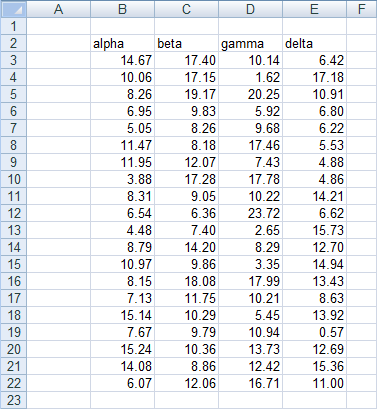
First, insert a bunch of blank rows, and set up a range for calculations. Only the horizontal version of the box plot uses the last calculated row, “Offset”. It will not hurt to include it in the vertical box plot’s calculations.

First, compute some simple statistics, such as the count, mean, and standard deviation. The formulas used in column B are shown in column G of the screen shot.

Now let’s compute the minimum and maximum, median, and first and third quartiles.

Finally, let’s determine which values we need to plot. Our chart has a box for the second quartile, which shows the difference between median and first quartile calculated above. It has a box for third quartile, which show the difference between the third quartile calculation and the median. The bottom of the lower box rests on the first calculated quartile. The down whisker is as long as the first quartile minus the minimum, and the up whisker is as long as the maximum minus the third quartile.
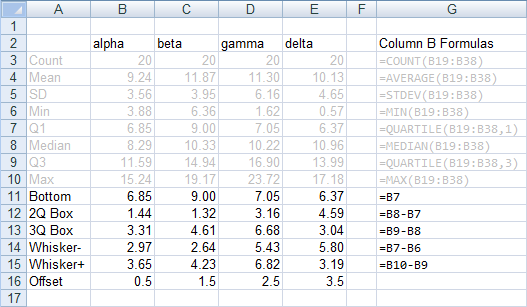
The offset values are calculated as follows: In my example, I have four categories, Alpha through Delta. I can divide my horizontal chart into four horizontal strips, numbered from 0 to 4, each containing one box-and-whisker unit. I need to position my average points in the middle of each 1-unit horizontal strip. These will ultimately go onto a secondary vertical axis which I will have conveniently scaled from 0 to 4. Hence the Y values I will need are 0.5, 1.5, 2.5, and 3.5.
Chart Construction
Select the header row of the calculated data, then hold Ctrl while selecting the three rows that include Bottom, 2Q Box, and 3Q Box. This multiple-area range is highlighted in orange below.
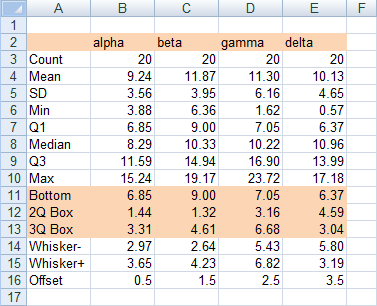
With this range selected, insert a stacked column chart or a stacked bar chart. Be sure to use the stacked version, and not the 100% stacked version, of the column or bar chart.
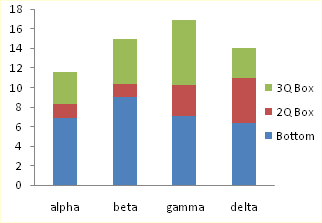
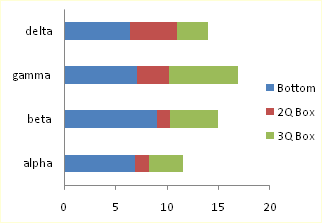
The labels in the bar chart go bottom-to-top. To reverse the labels, select the vertical axis, press Ctrl-1 (numeral one) to open the Format Axis dialog, then check the “Categories in Reverse Order” box, then under “Horizontal Axis Crosses”, select “At maximum category”.
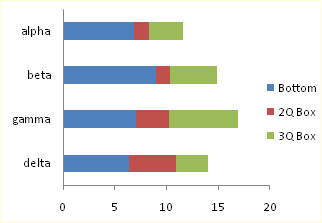
To add the down whisker, select the Bottom series, then in the Chart Tools > Layout tab, click Error Bars, and select More Error Bar Options from the bottom of the menu. Choose the Minus direction, select Custom for Error Amount, and click on Specify Value. Leave the contents of the Positive Error Value box alone (“={1}”) in the mini dialog that appears, then clear the Negative Error Value box and select the Whisker- row from the table (B14:E14). Click OK and Close to get back to Excel. These “down” error bars (whiskers) extend from the bottom (left) edge of the 2Q Box downward (leftward) into the Bottom series.
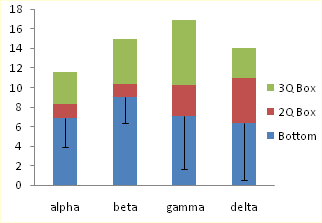
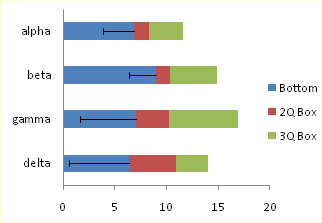
To add the up whisker, select the 3Q Box series,then in the Chart Tools > Layout tab, click Error Bars, and select More Error Bar Options from the bottom of the menu. Choose the Plus direction, select Custom for Error Amount, and click on Specify Value. Leave the contents of the Negative Error Value box alone (“={1}”) in the mini dialog that appears, then clear the Positive Error Value box and select the Whisker+ row from the table (B15:E15). Click OK and Close to get back to Excel.
These “up” error bars (whiskers) extend upward (rightward) from the top (right) of the 3Q Box.
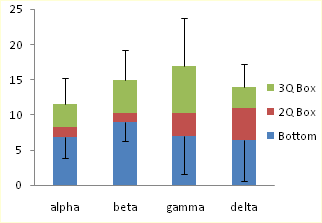
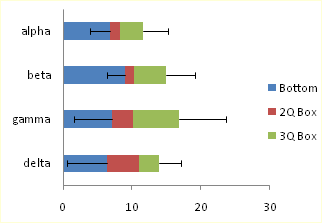
Now we can format the boxes. Select the Bottom series, and apply no fill and no border, so it is hidden. Then select each of the 2Q Box and 3Q Box series, and apply a dark border and a light fill.
Adding the Mean
To add the mean as a series of markers, select the Mean row in the calculated range (highlighted in blue). If you are making a horizontal box plot, hold Ctrl and also select the Offset row (highlighted in green), so both areas are selected. Copy the selected range.

Select the chart, and use Paste Special to add the data as a new series. If you are making a horizontal box and whisker diagram, check the “Category (X Labels) in First Row” box. The “Series Names in First Column” box should already be checked.
The new series is added as another column or bar stacked on top of the existing ones.
Select this new series, then on the Chart Tools > Design tab, click on Change Chart Type. If you are making a vertical box plot, choose a Line Chart style. If you are making a horizontal box plot, choose an XY Scatter style.
The points in the horizontal box plot are in reverse order. To change the order of points, select the secondary vertical axis (right edge of the chart), press Ctrl-1 (numeral one) to open the Format Axis dialog, then check the “Values in Reverse Order” box.
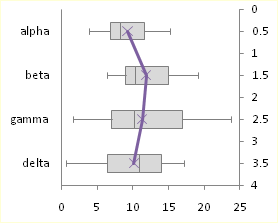
If you’re making a horizontal box plot in Excel 2003, this last process is a little more involved. Excel draws both secondary axes, but the vertical one is hidden behind the primary axis with the text labels (below left). Double click on the secondary horizontal axis (top of chart), and on the scale tab of the Format Axis dialog, check “Value (Y) Axis Crosses at Maximum Value” (below right).
Excel 2003, continued: Double click the secondary vertical axis (right of chart), and on the scale tab, check “Values in Reverse Order” and uncheck “Value (X) Axis Crosses at Maximum Value” (below left). Finally, select the secondary horizontal axis (top) and click Delete; Excel will now plot the XY series on the primary horizontal axis.
All Versions: Now format the mean series: remove the line, and use an appropriate marker of a contrasting color. If you’ve made a horizontal box plot, hide the secondary Y axis (right edge of the chart) by choosing no tick marks, no tick labels, and no line in the Format Axis dialog.
That was easy and didn’t take too long.
Box and Whisker Charts in Peltier Tech Charts for Excel

This tutorial shows how to create Box and Whisker Charts (Box Plots), including the specialized data layout needed, and the detailed combination of chart series and chart types required. This manual process takes time, is prone to error, and becomes tedious.
I have created Peltier Tech Charts for Excel to create Box Plots (and many other custom charts) automatically from raw data. This utility, a standard Excel add-in, lays out data in the required layout, then constructs a chart with the right combination of chart types.
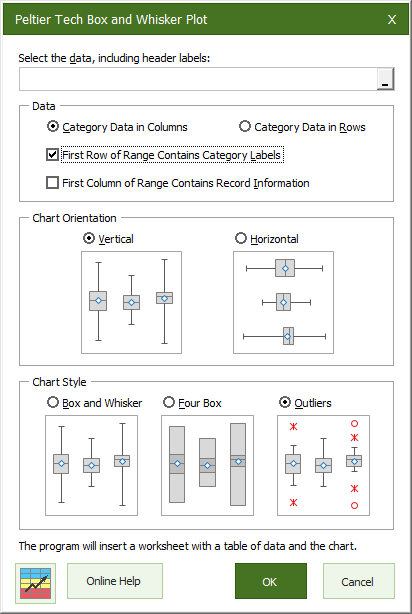
The utility creates vertical Box Plots …
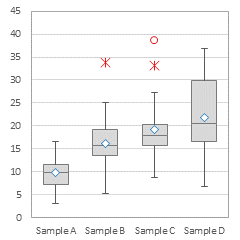
… horizontal Box Plots …
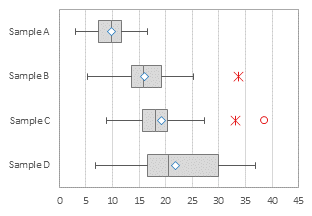
… and Grouped Box Plots …

Outliers can be shown or hidden, and a number of quartile definition options are available.
This is a commercial product, tested on thousands of machines in a wide variety of configurations, Windows and Mac, which saves time and aggravation.
Please visit the Peltier Tech Charts for Excel page for more information.
A box plot is a type of plot that we can use to visualize the five number summary of a dataset, which includes:
- The minimum
- The first quartile
- The median
- The third quartile
- The maximum
This tutorial explains how to create and interpret box plots in Excel.
How to Create a Box Plot in Excel
Perform the following steps to create a box plot in Excel.
Step 1: Enter the data.
Enter the data in one column.
Step 2: Create the box plot.
Highlight all of the data values.
On the Insert tab, go to the Charts group and click the Statistic Chart symbol.
Click Box and Whisker. A box plot will automatically appear:
To see the actual values that are summarized in the box plot, click on the plot. Then click the green plus sign that appears in the top right corner. Then check the box next to Data Labels. The following labels will automatically appear:
Here is how to interpret the labels in the box plot:
Min: 3. This is the smallest value in the dataset that is not considered an outlier. For this particular example, there are no outliers.
Q1: 5.25. This is the value of the first quartile in the dataset.
Median: 15. This is the median value in the dataset.
Mean: 14.75. The tiny “x” in the middle of the box represents the mean of the dataset.
Q3: 23.75. This is the value of the third quartile in the dataset.
Max: 29. This is the largest value in the dataset that is not considered an outlier. For this particular example, there are no outliers.
The screenshot below shows the exact formulas you can use in Excel to find each of these values:
A Note on Outliers
The interquartile range (IQR) is the distance between the third quartile and the first quartile. Excel considers any data value to be an “outlier” if it is 1.5 times the IQR larger than the third quartile or 1.5 times the IQR smaller than the first quartile.
In this example, the IQR is 23.75 – 5.25 = 18.5. Thus, any value smaller than 5.25 – (18.5 * 1.5) = -22.5 or any value larger than 23.75 + (18.5 * 1.5) = 51.5 would be considered an outlier.
Since no value in the dataset is smaller than -22.5 or larger than 51.5, there are no dots that appear in the box plot to indicate outliers. However, if our largest value was actually 52 then the box plot would show a dot to indicate the outlier:
How to Create Multiple Box Plots in Excel
You can easily create multiple box plots in Excel by simply entering more than one dataset in separate columns.
For example, suppose we have two datasets. To create a boxplot for each dataset, we would simply highlight both columns of data:
Then once again on the Insert tab, go to the Charts group and click the Statistic Chart symbol.
Click Box and Whisker. A box plot for each dataset will automatically appear:
This is particularly useful if we want to quickly visualize the distributions of two or more datasets.
Содержание
- How to Make a Box Plot in Excel
- What Is a Box Plot?
- How to Make a Box Plot in Excel for Microsoft 365
- Formatting a Box Chart in Excel
- A Welcome Addition for Statistical Analysis
- Create a box and whisker chart
- Create a box and whisker chart
- Change box and whisker chart options
- Create a box and whisker chart
- Change box and whisker chart options
- Диаграмма «ящик с усами» (boxplot) в Excel 2016
- Настройки диаграммы «ящик с усами»
How to Make a Box Plot in Excel
If you’re presenting or analyzing difficult statistical data, you might need to know how to make a box plot in Excel. Here’s what you’ll need to do.
Microsoft Excel allows you to create informative and attractive charts and graphs to help present or analyze your data. You can easily create bar and pie charts from your data, but creating a box plot in Excel has always been more challenging for users to master.
The software didn’t provide a template specifically for creating box plots, but it’s much easier now. If you want to make a box plot in Excel, here’s what you’ll need to know (and do).
What Is a Box Plot?
For descriptive statistics, a box plot is one of the best ways to demonstrate how data is distributed. It shows the numbers in quartiles, highlighting the mean value as well as the outliers. Statistical analysis uses box plot charts for everything from comparing medical trial results to contrasting different teachers’ test scores.
The basis for a box plot is to display data based on a five-number summary. This means showing:
- Minimum value: the lowest data point in the data set, excluding any outliers.
- Maximum value: the highest data point in the data set, excluding outliers.
- Median: the middle value in the data set
- First, or Lower, quartile: this is the median of the lower half of the values in the data set.
- Third, or Upper, quartile: the median of the upper half of the data set’s values
Sometimes, a box plot chart will have lines extending vertically up or down, showing how the data might vary outside the upper and lower quartiles. These are called “whiskers,” and the charts themselves are sometimes referred to as box and whisker charts.
How to Make a Box Plot in Excel for Microsoft 365
In past versions of Excel, there wasn’t a chart template specific to box plots. While it was still possible to create it, it took a lot of work. Office 365 does include box plots as an option now, but it’s somewhat buried in the Insert tab.
The instructions and screenshots below assume Excel for Microsoft 365. The steps below have been created using a Mac, but we also provide instructions where the steps are different on Windows.
First, of course, you need your data. Once you’ve finished entering it, you can create and stylize your box plot.
To create a box plot in Excel:
- Select your data in your Excel workbook—either a single or multiple data series.
- On the ribbon bar, click the Insert tab.
- On Windows, click Insert > Insert Statistic Chart > Box and Whisker.
- On macOS, click the Statistical Chart icon, then select Box and Whisker.
That will net you a very basic box plot, with whiskers. Next, you can modify its options to look how you want.
Formatting a Box Chart in Excel
Once you’ve created your box plot, it’s time to pretty it up. The first thing you should do is give the chart a descriptive title. To do this, click the existing title, then you can select the text and change it.
From the Design and Format tabs of the ribbon, you can modify how Excel styles your box chart. This is where you can select the theme styles used, change the fill color of the boxes, apply WordArt styles, and more. These options are universal to just about all of the charts and graphs you might create in Excel.
If you want to change options specific to the box and whisper chart, click Format Pane. Here, you can change how the chart represents your data. For example:
A Welcome Addition for Statistical Analysis
It wasn’t always so easy to figure out how to create a box plot in Excel. Creating the chart in previous versions of the spreadsheet software required manually calculating the different quartiles. You could then create a bar graph to approximate the presentation of a box plot. Microsoft’s addition of this chart type with Office 365 and Microsoft 365 is very welcome.
Of course, there are lots of other Excel tips and tricks you can learn if you’re new to Excel. Box plots might seem advanced, but once you understand the concepts (and the steps), they’re easy to create and analyze using the steps above.
Источник
Create a box and whisker chart
A box and whisker chart shows distribution of data into quartiles, highlighting the mean and outliers. The boxes may have lines extending vertically called “whiskers”. These lines indicate variability outside the upper and lower quartiles, and any point outside those lines or whiskers is considered an outlier.
Box and whisker charts are most commonly used in statistical analysis. For example, you could use a box and whisker chart to compare medical trial results or teachers’ test scores.
Create a box and whisker chart
Select your data—either a single data series, or multiple data series.
(The data shown in the following illustration is a portion of the data used to create the sample chart shown above.)
In Excel, click Insert > Insert Statistic Chart > Box and Whisker as shown in the following illustration.
Important: In Word, Outlook, and PowerPoint, this step works a little differently:
On the Insert tab, in the Illustrations group, click Chart.
In the Insert Chart dialog box, on the All Charts tab, click Box & Whisker.
Use the Design and Format tabs to customize the look of your chart.
If you don’t see these tabs, click anywhere in the box and whisker chart to add the Chart Tools to the ribbon.
Change box and whisker chart options
Right-click one of the boxes on the chart to select that box and then, on the shortcut menu, click Format Data Series.
In the Format Data Series pane, with Series Options selected, make the changes that you want.
(The information in the chart following the illustration can help you make your choices.)
Controls the gap between the categories.
Show inner points
Displays the data points that lie between the lower whisker line and the upper whisker line.
Show outlier points
Displays the outlier points that lie either below the lower whisker line or above the upper whisker line.
Show mean markers
Displays the mean marker of the selected series.
Displays the line connecting the means of the boxes in the selected series.
Choose a method for median calculation:
Inclusive median The median is included in the calculation if N (the number of values in the data) is odd.
Exclusive median The median is excluded from the calculation if N (the number of values in the data) is odd.
Tip: To read more about the box and whisker chart and how it helps you visualize statistical data, see this blog post on the histogram, Pareto, and box and whisker chart by the Excel team. You may also be interested learning more about the other new chart types described in this blog post.
Create a box and whisker chart
Select your data—either a single data series, or multiple data series.
(The data shown in the following illustration is a portion of the data used to create the sample chart shown above.)
On the ribbon, click the Insert tab, and then click 
Use the Chart Design and Format tabs to customize the look of your chart.
If you don’t see the Chart Design and Format tabs, click anywhere in the box and whisker chart to add them to the ribbon.
Change box and whisker chart options
Click one of the boxes on the chart to select that box and then in the ribbon click Format.
Use the tools in the Format ribbon tab to make the changes that you want.
Источник
Диаграмма «ящик с усами» (boxplot) в Excel 2016
Excel 2016, как известно, обогатился новыми типами диаграмм. Одна такая, которая диаграмма Парето, уже была показана. В этот раз рассмотрим другую, чисто статистическую. Называется «ящик с усами» или «коробчатая диаграмма» (box-and-whiskers plot или boxplot).
Раньше я такие видел только в специализированных ПО, типа STATISTICA, и для того, чтобы нарисовать подобную диаграмму в Excel, нужно было изрядно потрудиться. Теперь она есть в стандартном наборе Excel.
Зачем нужна такая диаграмма? Допустим, есть выборка для анализа. А еще лучше несколько выборок, которые нужно сравнить. Для этого рассчитывают различные показатели. Однако к любому расчету всегда хочется добавить наглядности, чтобы мозг перешел в режим образного представления, а не довольствовался сухими цифрами и формулами. Поэтому основные характеристики ловко изображают на рисунке. Отличным вариантом будет как раз диаграмма «ящик с усами».
На рисунке показан формат по умолчанию. Как видно, сравниваются две выборки путем изображения двух «ящиков с усами».
Что здесь что обозначает?
Крестик посередине – это среднее арифметическое по выборке.
Линия чуть выше или ниже крестика – медиана.
Нижняя и верхняя грань прямоугольника (типа ящика) соответствует первому и третьему квартилю (значениям, отделяющим ¼ и ¾ выборки). Расстояние между 1-м и 3-м квартилем – это межквартильный размах (или расстояние).
Горизонтальные черточки на конце «усов» – максимальное и минимальное значение (без учета выбросов, см. ниже).
Отдельные точки – это выбросы, которые показываются по умолчанию. Если значение выходит за пределы 1,5 межквартильных размаха от ближайшего квартиля, то оно считается аномальным. Их можно скрыть (см. ниже настройки).
Во всей красе «ящик с усами» проявляется при сравнении выборок, в которых данные делятся на категории. Допустим, провели некоторый эксперимент среди мужчин и женщин. Есть данные до и после эксперимента по обоим полам. Для анализа потребуется вычислить различные показатели. А если к этому добавить диаграмму «ящик с усами», то результат будет весьма наглядным.
Отлично видно, что после проведения эксперимента данные по мужчинам в целом уменьшились, а данные среди женщин наоборот, увеличились. Это не значит, что выборки больше не нужно анализировать (сравнивать, проверять гипотезы и т.д.). Но наглядность сильно улучшает понимание. Перейдем к настройкам.
Настройки диаграммы «ящик с усами»
Общий вид диаграммы настраивается стандартно. Можно менять цвет, добавлять подписи и т.д. Для этого есть две контекстные вкладки на ленте (Конструктор и Формат). Но есть настройки, предназначенные специально для этой диаграммы.
Выбираем какой-либо ряд и жмем Ctrl+1. Либо два раза кликаем по какому-нибудь «ящику». Можно через правую кнопку Формат ряда данных…. Справа вылазит панель настроек.
Рассмотрим по порядку.
Боковой зазор – регулирует ширину ящиков и расстояние между ними.
Показывать внутренние точки. Если поставить галочку, то на оси, где расположены «усы», точками будут показаны все значения. Так хорошо видно распределение внутри групп.
Показывать точки выбросов – отражать экстремальные значения.
Выбросы – это точки, выходящие за пределы 1,5 межквартильных размаха.
Показать средние метки – среднее арифметическое (крестики). Стоят по умолчанию, но можно скрыть.
Показать среднюю линию – только для различных категорий. Показывает изменения по категориям.
Если добавить линии, то изменения после эксперимента станут видны еще лучше. В справке написано, что соединяются медианы, но на графике почему-то соединяются средние. Чудеса.
Инклюзивная медиана или эксклюзивная медиана. Инклюзивная медиана включает в «ящик» квартильные значения , а эксклюзивная медиана не включает. При выборе «эксклюзивной медианы» верх и низ «ящика» соответствует средней между квартильным и следующим (от центра) значением. По умолчанию стоит «эксклюзивная». Пусть стоит дальше. Причем тут медиана, вообще не понял, – речь ведь про квартиль. Думал, криво перевели, но в английской версии те же названия. В общем, здесь лучше ничего не менять.
Своевременное использование диаграммы «ящик-усы» может дать весьма ценную и наглядную информацию. Аналитику, который использует специализированные программы или трудоемкие настройки Excel, будет очень приятно иметь такую диаграмму под рукой.
Как показано в ролике ниже, все делается очень быстро и просто.
Источник

